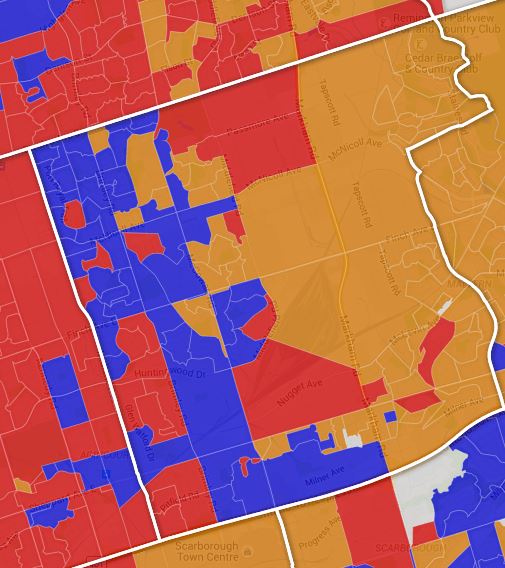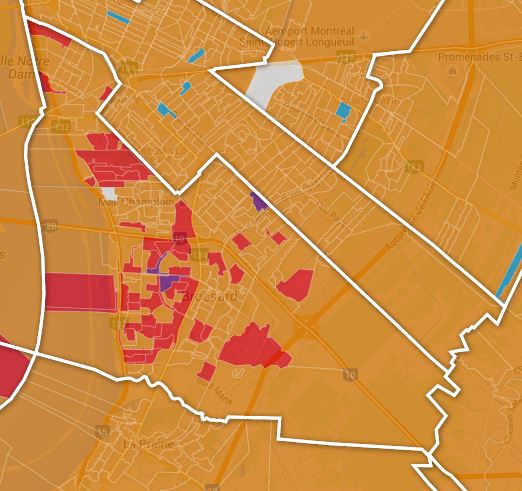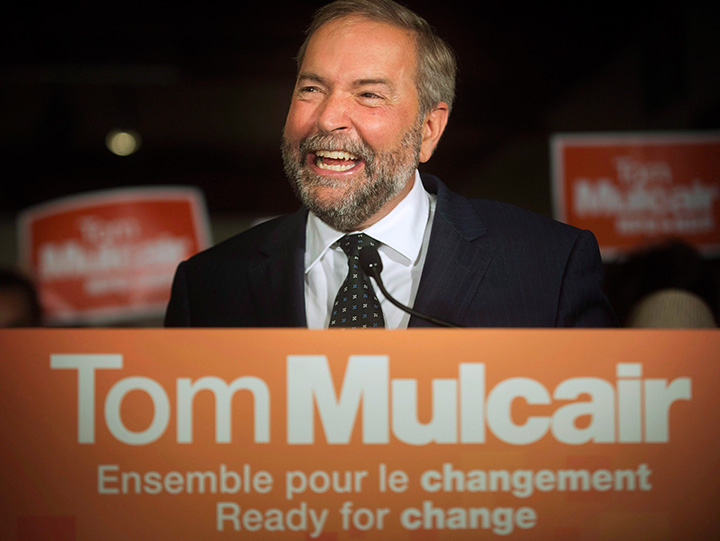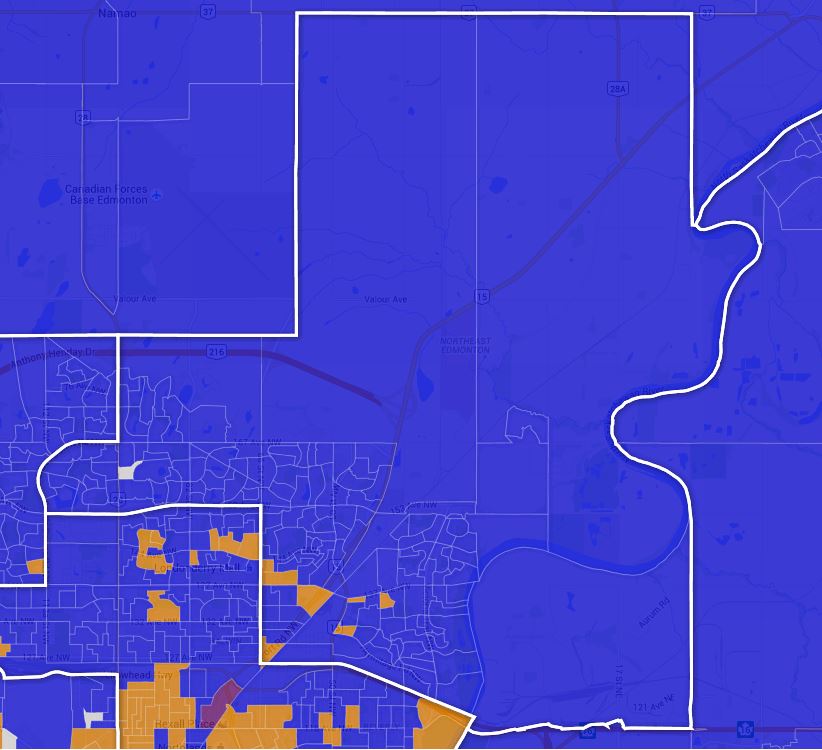The NDP currently has a small lead in the majority of the polls, but in a crowded three-way race, how does the party translate that lead into a victory on election night?

Polls show the Liberal Party consistently leading by a wide margin in Atlantic Canada. There are 50 to 60 rural seats from Alberta to Ontario that have elected Conservatives by huge margins in past elections, and show few signs of becoming toss-up seats.
And having won 59 of 75 ridings in Quebec last election, there’s little room for the party to pick up more seats there, even with their high poll numbers.
But there is a realistic route to a minority government. Analysis by the Laurier Institute for the Study of Public Opinion and Policy (LISPOP) projects the NDP to win 128 seats, compared to 106 for the Conservatives and 103 for the Liberals.
See the LISPOP map below:
To gain the most seats, the NDP must first hold onto virtually all of the 103 ridings they won last election.
Then, they must add seats in regions of Ontario where they’ve had some historical success, western Canadian cities where they’ve become the established alternative to the Conservatives and around 10 traditionally Conservative seats in British Columbia, where the party hopes an orange wave across the province will put the finishing touches on a victory come election night.
If the NDP does form government, here are 10 seats from coast to coast where they’ll likely win.
1. Burnaby North-Seymour
2011 result (based on current boundaries): 2nd place, 35.2 per cent
Current LISPOP projection: NDP
One of six new ridings in British Columbia, this oddly shaped electoral district includes the northern half of Burnaby (which tends to favour the NDP) and the eastern half of the District of North Vancouver (which tends to favour the Conservatives).
The Conservatives received the most votes in this area in 2011 and their candidate, three-term North Vancouver councillor Mike Little, is formidable — but so is NDP candidate Carol Baird Ellan, the first female chief justice of B.C.’s Supreme Court.
Given the NDP’s lead among B.C. participants in national polls, Ellan is considered to have an edge. However, the Conservatives are making a concerted effort to attack Ellan as soft on crime, and the presence of strong candidates for the Liberals and Green Party could result in vote-splitting.
2. Kamloops-Thompson-Cariboo
2011 result (new seat, but based on results in polling stations within the boundaries): 2nd place, 36.9 per cent
Current LISPOP projection: Leaning NDP
Two-term Conservative MP Cathy McLeod is well-liked in this riding, and the NDP haven’t won the Kamloops-based riding since 2000.
However, the NDP believe they have a chance in several B.C. interior ridings, and Mulcair spent several days in the region earlier this month. Provincially, the Kamloops region has been a bellwether seat between the NDP and the dominant right-wing party for decades.
The NDP are hoping to take Kootenay—Columbia, South Okanagan—West Kootenay, and multiple rural ridings on Vancouver Island from the Conservatives. If they can win here, they will likely win there.
3. Edmonton Manning
2011 result (based on current boundaries): 2nd place, 26.6 per cent
Current LISPOP projection: Too close to call
Can the NDP’s dominance in Edmonton last provincial election extend to the federal election?
Including St. Albert-Edmonton, there are eight urban ridings in Edmonton, up from five in 2011.
Edmonton Strathcona is expected to re-elect NDP MP Linda Duncan, and the party will be competitive in Edmonton Centre and Edmonton Griesbach near the centre of the city.
But whether the party can succeed in the outer suburban ridings is an open question. A good test will be Edmonton Manning, where there is no incumbent and none of the candidates are particularly high-profile. The NDP’s Aaron Paquette, an aboriginal artist, will need to defeat Conservative candidate Ziad Aboultaif, owner of a distribution business.
4. Saskatoon-Grasswood

2011 result (new seat, but based on results in polling stations within the boundaries): 2nd place, 39.8 per cent
Current LISPOP projection: Too close to call
Can the NDP win a seat in Saskatchewan for the first time since 2000? They’re optimistic, and part of that comes from the new boundaries for the Saskatoon-based seats.
From 2000 to 2013, Saskatoon and the surrounding areas had been divided up into four ridings that contained part of Saskatoon, and part of the surrounding rural areas. In all five elections, the Conservatives took all four seats.
After redistribution, there are two ridings completely in Saskatoon, along this district, which includes some rural areas to the southwest of the city.
Conservative MP Lynne Yelich lost her nomination battle here to Kevin Waugh, a longtime sports anchor at CTV Saskatoon. He faces Scott Bell, a federal lawyer specializing in aboriginal law.
Simply put, if the NDP win this seat, it bodes well for their chances in the other two Saskatoon-based seats.
5. Kenora

2011 result (based on current boundaries): 2nd place, 27.9 per cent
Current LISPOP projection: Too close to call
This may be one of the most interesting three-way races in the country. It’s certainly the race with the most collective political experience between the candidates.
Conservative MP and Natural Resources Minister Greg Rickford has held this riding since 2008 and defeated NDP candidate Tania Cameron by 19.9 per cent last election.
But the NDP are countering with former provincial leader Howard Hampton, who was an MPP in this area from 1987 to 2011.
The Liberal candidate is no slouch either —Bob Nault was MP here from 1988 to 2004, served as Minister of Indian Affairs and Northern Development, and was never defeated federally.
Add it up, and Kenora is a seat all three parties could win—but one the NDP would very much like as they aim to sweep northern Ontario.
6. Essex
2011 result (based on current boundaries): 2nd place, 34.9 per cent
Current LISPOP projection: Too close to call
There are a number of semi-urban, semi-rural ridings in Ontario, many with a strong industrial heritage, that the NDP would like to take from the Conservatives this election. Essex is one of their biggest targets.
Last election, Conservative MP Jeff Watson defeated NDP candidate Taras Natyshak by 12.9 per cent, one of the party’s smallest margins of victory in Ontario outside a major city.
This time around, the NDP candidate is Tracey Ramsey, an assembler at Ford’s Essex Engine Plant and local union leader.
7. Scarborough North

2011 result (based on current boundaries): 1st place, 35.4 per cent
Current LISPOP projection: Too close to call
The new seat in Scarborough, NDP Rathika Sitsabaiesan has moved over from Scarborough-Rouge River to seek re-election here, a riding where over two-thirds of residents are immigrants, the highest number in Canada.
It’ll be a tough fight. If this riding existed in 2011, the NDP would have won by just two per cent over the Conservatives, and they are running a strong candidate in Ravinder Malhi.
And while the Liberals finished a close third in this area last election, their candidate might be the highest profile: Shaun Chen, the former chair of the Toronto District School Board.
The NDP won eight seats in Toronto last election, but with the Liberals well ahead of their historic 2011 lows in the polls, they’ll be well-served to match that total this time around.
8. Oshawa

2011 result (based on current boundaries): 2nd place, 37.1 per cent
Current LISPOP projection: Too close to call
Last year, the NDP ended the 19-year reign of provincial PC MPP Jerry Ouellette in Oshawa, and they’re hopeful for a similar result federally.
Former leader Ed Broadbent’s riding from 1968 to 1990, the NDP hope Mary Fowler can defeat four-term Conservative MP Colin Carrie in Oshawa.
The blue-collar riding is one that projects well for the NDP, but much will depend on the performance of the Liberal candidate, former councillor Tito-Dante Marimpietri. His party only received seven per cent of the vote here last time—and it will need to be low again for the NDP to have a chance here.
9. Brossard-Saint Lambert

2011 result (based on current boundaries): 1st place, 36.8 per cent
Current LISPOP projection: Too close to call
In Quebec, the main question for the NDP isn’t what new seats they can win—it’s whether they hold onto all the seats they won in the province for the first time in 2011.
Brossard-Saint Lambert is considered a key test for the party. NDP MP Hoang Mai won the former riding of Brossard-La Prairie by 13.7 per cent in 2011. Within the boundaries of this new riding, residents only voted for NDP candidates by four per cent more than Liberal candidates in the last election.
In addition, Hoang Mai is facing a rematch against the Liberal’s Alexandra Mendès, who was MP from 2008 to 2011 in Brossard—La Prairie.
The takeaway? If the NDP can hold Brossard-La Prairie, they should be able to hold virtually all of the 59 ridings they won in Quebec last election.
10. St. John’s South-Mount Pearl
2011 result (new seat, but based on results in polling stations within the boundaries): 1st place, 46.3 per cent
Current LISPOP projection: NDP
In Atlantic Canada, polls have consistently shown the Liberals with between 40 and 55 per cent of the vote, a number that would make them the overwhelming favourites in many ridings.
As such, the NDP will mostly focus on retaining the six seats they currently have.
Their most vulnerable seat outside of Dartmouth-Cole Harbour is St. John’s South-Mount Pearl, where NDP MP Ryan Cleary defeated Liberal incumbent Siobhan Coady by 19.4 per cent last election to win the seat.
The Liberal candidate this time around is Seamus O’Regan, the longtime former host of Canada AM.








Comments